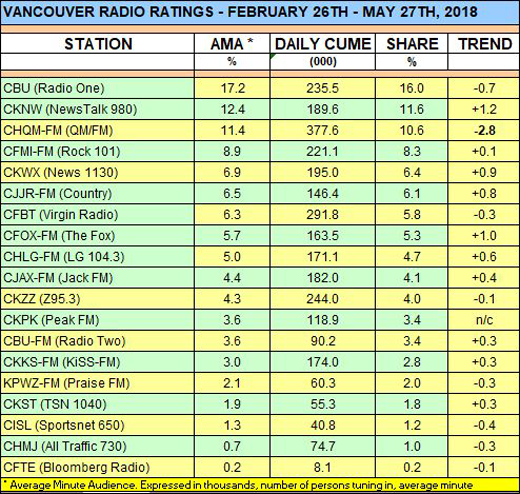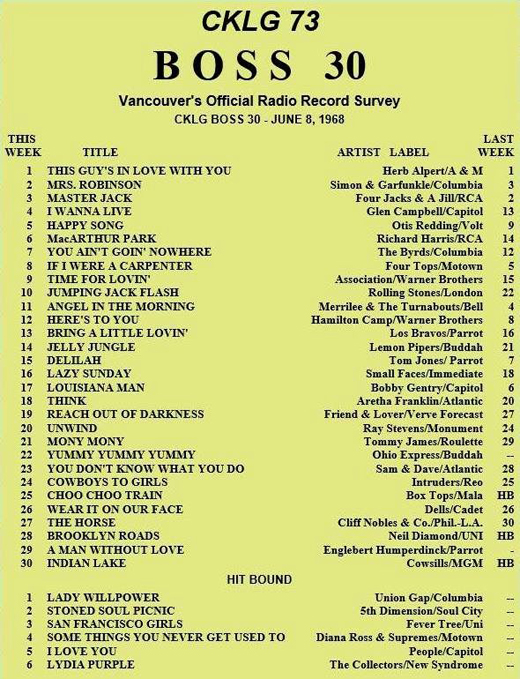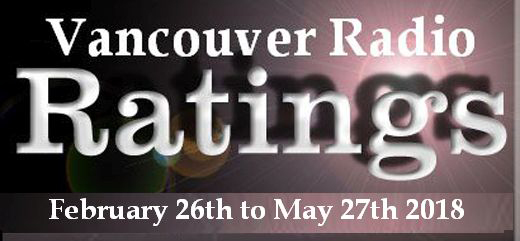 One in six people are listening to CBC Radio One in Vancouver at any given time
One in six people are listening to CBC Radio One in Vancouver at any given time
As I have written previously, in 1957 I received a transistor radio on August 11th, the date of my 7th birthday, which gift not only engendered a love for radio, but changed my life in significant ways.
By the time the mid-1960s rolled around, I had been hired as a rock ‘n roll deejay at the pop radio station of the day, CFUN 141, where I worked the occasional on-air shift, and read the news as directed by the news director, the late Jim Neilsen — who would go on to become British Columbia’s first environment minister, in the Socred government of Bill Bennett — as well as producing the Sunday evening foreground programming.
In 1966, a young upstart pop radio station sprung up in Vancouver — that had adopted a ‘hot clock’ format created by programme director Bill Drake for the lowest-rated radio station in the Los Angeles market, KHJ. Within three months of adopting what was called the ‘Drake format’ — which was also often referred to as Boss Radio — KHJ shot from last place to first in a Los Angeles radio market with over 70 radio stations.
Drake exported his Boss Radio format to hundreds of radio stations across North America, including 730 CKLG Vancouver. Within six months of adopting the BOSS radio Drake format, 730 CKLG shot from last place to second place in the Vancouver market, just behind powerhouse CKNW 98.
Within a year, CFUN was no more, converting to CKVN, the Voice of News.
A 1968 CKLG aircheck of J.B. Shayne, and various Boss radio station jingles. Hint: you’re gonna want to listen to the KRLA jingle (it’s the last one), which I acquired in 1972 from KRLA afternoon announcer, the legendary Shadoe Stevens. The jingle was played at the beginning of each announcer’s show, every three hours, from 6 a.m. til midnight.
All the jocks at CFUN left for CKLG, and LG-FM, including me: Terry David Mulligan, Don Richards, Daryl B., Fred Latremouille, and John Tanner, just to name a few. J.B. Shayne was already employed at the station, as he’d been hired in 1965 to do overnight on Lions Gate radio, playing classical music — which was, as you might imagine, a joy for the inimitable Mr. Shayne (not!). After adopting the Boss Radio format, Shayne remained at the station, continuing on overnights, becoming a Vancouver radio legend.
 Courtesy of Ricardo Zborovszky. What has always impressed me about Top 30 music charts from the 1960s is the diversity of the music that was being played on radio, everything from Motown to pop, middle-of-the-road music for parents from Englebert Humperdinck, to trippy local psychedelia from The Collectors and their 1968 hit Lydia Purple to blues rock from the Rolling Stones & Americana folk from Simon & Garfunkel
Courtesy of Ricardo Zborovszky. What has always impressed me about Top 30 music charts from the 1960s is the diversity of the music that was being played on radio, everything from Motown to pop, middle-of-the-road music for parents from Englebert Humperdinck, to trippy local psychedelia from The Collectors and their 1968 hit Lydia Purple to blues rock from the Rolling Stones & Americana folk from Simon & Garfunkel
In time to come, in VanRamblings Stories of a Life feature, I’ll write about my days in radio, including the very public broadcast throughout the entire Kootenay region of the loss of my virginity, a fond memory even to this day.

Believe it or not, there are actually people who listen to radio in this day and age of iPhones and iPods, loaded with 128GB of your favourite music downloaded onto your smartphone device with thousands of songs available at the call of Siri or Google Assistant, bluetooth, and streaming music services like Spotify, Apple Music and SiriuxXM — and, heck, it’s not all old fogeys like the publisher of this blog, either, who listen to radio.

Host Stephen Quinn dominates the radio market mornings Monday to Friday in Vancouver, on CBC Radio One’s The Early Edition, having taken over from longtime host Rick Cluff, when after some 20+ years, Mr. Cluff retired to his West Vancouver home during the holiday season that ended 2017, as it did Mr. Cluff’s 40+ year celebrated history in public radio.
If you want to know what’s going on in our city, our region and the province of British Columbia, you tune into Quinn’s The Early Edition, over the lunch hour on BC Today with Michelle Eliot, or Gloria Mackarenko’s re-invented On The Coast afternoon show — any and all issues of interest and concern are addressed on these three locally-produced broadcasts, featuring interviews with the broadest range of political figures, commentators, academics, and activists in our region and our province.
Little wonder that CBC Radio One dominates Vancouver’s radio market.
Although, CKNW comes in second in the Vancouver radio market in this last ratings “book,” the audience for that station is mainly 55+, hardly the demographic the advertisers want to reach, or so we keep being told.
QM/FM, although it’s ratings dropped a bit from the last time ratings were calculated, Vancouver’s oldest and most reliable music station continues to dominate the traditional radio market, as has been the case for more than 30 years, with its playlist of soft rock and classic radio favourites, with the occasional middle-of-the road contemporary song thrown into the mix.
Otherwise, Virgin Radio, Z95.3 and and KiSS Radio continue to compete for the ears of young listeners, a job they’re mostly successful at achieving.
Courtesy of Broadcast Dialogue magazine, David Bray, June 7th 2018
Vancouver: CBC Radio One continues its dominance of the Vancouver radio market, grabbing the #1 spot for A12+ with a 15.3% share of hours tuned (down from 15.7%). Taking the top spot for F25-54, QM-FM, posting a 16.5% share (down from 19.6% last book). FOX grabs the lead for M25-54 listeners, delivering a 13.8% share (up from 11.4%). The FOX is out in front for M18-34 with a 22.0% share of hours tuned (up from 15.8%). Women 18-34, QM-FM dominates, taking top spot with a 16.8 % share.
Even given its low ratings, TSN 1040 dominates the radio market, men aged 25 – 44, and 45 – 64, so for advertisers who want to reach that target market, TSN 1040 is the station that they’ll turn to more often than not.
Well, that’s it for this sort of Arts Friday VanRamblings post. Feels good to take a bit of break from the ever-so-satisfying maelstrom of local politics.